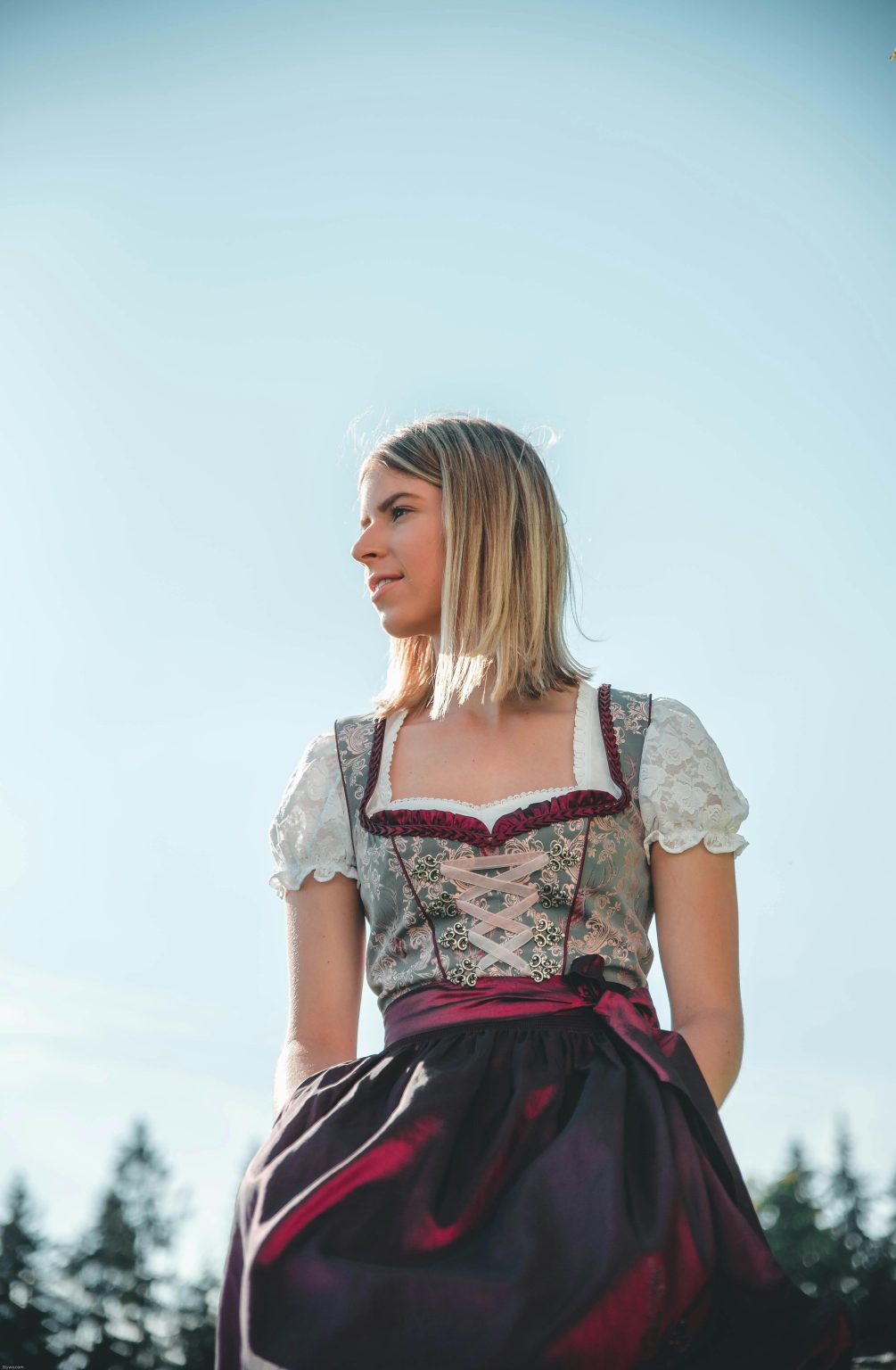Dirndl dresses are available in tons of designs, cuts, and colors. Choosing the one that fits right for Oktoberfest is a way to appreciate the Bavarian tradition!
Shopping for the unofficial women’s Oktoberfest outfit “dirndl” is a daunting task. Many things go into finding the right dress, from having the knowledge of the authentic three-component design to deciding the right length (mini, midi or maxi) and style.
Since dirndl comes in many fabrics, colors, and sizes, it is important to purchase the one that rightly fits to accentuate the curves proportionally. Accessories are the vitamins of fashion, and during the dirndl shopping spree, buying a complementing blouse and shoes is also indispensable.
What is the Authentic Dirndl Design?
Dirndl originally consisted of three distinct parts that made it different from other types of dresses. The design of the authentic outfit has been preserved for centuries.
The Bodice
The bodice is a fitted garment with a deep neckline. It is usually crafted as a single piece and fastened at the centre front using lacing, buttons, hook-and-eye closures, or a zipper. In some designs, the zipper is also sometimes located at the back or side. Traditional bodices were made from dark, heavy cotton for durability. Modern designs, however, use a variety of materials such as cotton, linen, velvet, or silk.
Skirt
The skirt is designed to be full, with pleats gathered at the waist. Prior to the 1930s, the skirt was separate from the bodice, but modern designs feature the two sewn together. Traditional skirts were long, though contemporary styles often feature mid-length or even mini versions. The traditional design also had a hidden pocket, typically located on the side or front of the skirt and concealed beneath the apron.
Apron
The apron is a narrow piece attached to the skirt that covers only the front portion. Traditional aprons are influenced by regional customs and made in a single color. Modern aprons feature more intricate and decorative designs.
Factors to Consider When Shopping a Dirndl
Dirndl may seem like simple traditional wear, but many things come into play when shopping for a woman’s Oktoberfest costume. Some of these characteristics are essential for the right fit, while others define the style.
Traditional versus Modern Designs
There are two distinct styles of the women’s dirndl which include;
- Traditional Dirndl
- Modern Dirndl.
Traditional dirndls have an everyday and formal/ festival version. Everyday dirndls are practical rural clothing often made from grey or colored linen and may include leather bodices or trims. Formal outfit used for traditional festivals or special occasions is crafted from high-quality materials with designs, colors, and embroidery specific to the region of origin.
Some traditional dirndl designs include draped pieces over the chest, often paired with an elaborate collar. These elements conceal the décolletage, reflecting traditional Catholic values of modesty. Modern dirndls incorporate contemporary accents like shorter hemlines, lower necklines, and trending patterns.
| Dirndl Decision!The choice between the traditional and modern dirndl depends on your preference and cultural appreciation. Some women still wear the traditional regional version of the dirndl known as the “Isarwinkler costume” at Oktoberfest. |
Types of Dirndl Skirts
Three different types of dirndl are segregated based on the variation in costume length, and knowing which will suit you will help in making the decision.
Mini Dirndl Dress
Skirt lengths of approximately 50 to 60 cm long are perfect for women who are 1.7 meters tall or shorter. They are also excellent for spring and summer, offering comfort in warmer weather. Stylish and playful, these dresses are ideal for making a bold fashion statement.
Midi Dirndl Dress
A midi dress could be ideal for a more modest option that still highlights a hint of leg. Falling 60 -75cm just below the knee, these elegant dresses offer versatility and are suitable for a variety of events.
Maxi Dirndl Dress
The maxi-dirndl, which measures 90 cm to 100 cm and falls just above the ankle, is an excellent choice for those who prefer traditional designs, taller individuals, or those attending formal events. This elegant style is especially popular for bridalwear and creates a striking look when paired with a shape-enhancing petticoat.
Dirndl Fabric & Patterns
Dirndl dresses are available in a range of fabrics, each offering unique qualities suited for different weathers and events. Common materials include cotton, linen, silk, and velvet. Cotton and linen are ideal for warmer weather due to their breathability, while silk and velvet go perfectly with formal-themed events.
Patterns are a key element of dirndl design, often reflecting traditional motifs and cultural heritage. Understanding the cultural significance of these patterns can help you select a dirndl that aligns with Bavarian traditions and your personal style. Popular patterns include;
- paisley
- floral designs
- checkered prints
Size & Body Type
Accurate size and knowledge of body type are the secret codes that ensure the right fit of the dirndl dress. Dirndls are available in standard European sizes with equivalent International and USA sizes. The measurements of the bust and waist are important to determine which size category one falls into. Since the skirts are pleated, hip measurements are not necessary.
For the bust, measure across the fullest part of the chest and the area below your rib cage and hip bones for the waist. The Dirndl bodice ends a little above the waist, like high-waisted jeans or trousers. The size chart helps clarify any queries related to the fit.
Accessorizing the Dirndl Dress
Well, Dirndl shopping is incomplete without buying complementary accessories. Dirndl comes with an apron, but a blouse, shoes, or bag are bought separately to complete the Oktoberfest look.
Blouse
It is often considered part of the dirndl dress. Culturally, wearing a dirndl dress without a blouse is considered inappropriate. There are many choices in terms of this accessory, and it makes a huge difference in how the dress turns out as a whole. The Dirndl blouse has many options regarding neckline, sleeves, and fabrication. Off-white, white, taupe, beige and black are the most common colors these tops are made in.
The dirndl top should complement the traditional outfit in terms of color and cut. Some of the most common options for a dirndl blouse are;
- Carman blouse
- V-neck blouse
- Sweetheart neckline blouse
- Balconette blouse
- Long sleeves blouse
Shoes
There is no question that not wearing good shoes ruins the whole dirndl look. For instance, wearing flip-flops is socially and culturally unacceptable at the Oktoberfest fairgrounds. Closed toes and comfortable and elegant footwear complement the traditional attire well. Some of the most common shoe options include;
- Mary Jane
- Pump
- Patent Leather Closed Toe Shoes
- Wedges
Bags
Small bags in cute heart or pretzel shapes are optional choices for storing accessories like pocket deodorant or mini lipstick for touch-ups. Bags bigger than 20 cm x 15 cm x 10 cm are among the things not allowed to be taken to Oktoberfest.
Where to Buy Dirndl From?
In the past two decades, dirndl dress has gained popularity as an Oktoberfest outfit. There are two ways to purchase these outfits.
Physical Store
It is the most reliable option to source a traditional Oktoberfest outfit. The big boutiques in Munich are the prime locations, and many of them have been selling these attires for centuries. Traditional regional variants are easily accessible in these stores.
| ATTENTION!During the Oktoberfest season, many small stalls sell this low-quality traditional attire, which are the counterfeits of the original dirndl dresses sold for nearly 50-60 Euros. |
Online Stores
Globalization has liberated the world of fashion, and now anyone can buy dirndl from any corner of the world, just like the one sold in Munich or Bavaria. A reliable Bavarian specialized e-store like “Dirndl Delights” is a one-stop shop for authentic Oktoberfest outfits.
Wrapping It Up!
Dressing is a favourite hobby of every woman, and shopping for it even more! Buying a traditional Oktoberfest outfit requires some serious work, like finding an authentic dress and deciding the right length, color, pattern and size.
Dirndl and complementing accessories can be bought both physically and from online stores.



